This has been a solid week for comics, although without many true #1’s. Still, there are great new tales from a lot of indie publishers, and we also get to revisit some classic characters we love and see interesting departures in ongoing series.
 The first of this week’s new #1’s comes from a familiar franchise, brought to us by a less familiar comics publisher: Bongo Comics’ Professor Frink: Fantastic Science Fictions #1. Yup, THAT Professor Frink, of The Simpsons. This is essentially three short stories, filled with the wise-cracking characters we’ve all been watching on television for over two decades. There’s not a lot that’s new in the comic, but it’s fun to see a less well-known Simpsons regular like Professor Frink having some science-y fun! If you are a big hard-sciences nerd, or get you giggles from the fields of STEM, then this comic is loaded with exactly the kind of word play and puns that’ll have you chuckling all the way to the lab. It’s not an ongoing series to follow really, but it’s worth the read.
The first of this week’s new #1’s comes from a familiar franchise, brought to us by a less familiar comics publisher: Bongo Comics’ Professor Frink: Fantastic Science Fictions #1. Yup, THAT Professor Frink, of The Simpsons. This is essentially three short stories, filled with the wise-cracking characters we’ve all been watching on television for over two decades. There’s not a lot that’s new in the comic, but it’s fun to see a less well-known Simpsons regular like Professor Frink having some science-y fun! If you are a big hard-sciences nerd, or get you giggles from the fields of STEM, then this comic is loaded with exactly the kind of word play and puns that’ll have you chuckling all the way to the lab. It’s not an ongoing series to follow really, but it’s worth the read.
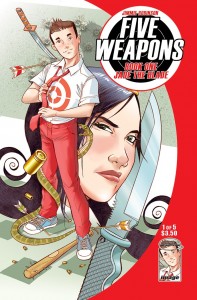 In more classic comic fare, Image Comics leads the way again with a pair of new #1’s. First up is a true beginning to a new series with Jimmie Robinson’s Five Weapons #1. This book is remarkable in that it was written, drawn and lettered by its creator, which is no small feat. The story revolves around a school for children of professional assassins and warriors, and its newest student, Tyler Shainline. The Shainline family are a kind of royalty among professional killers, a name as well revered in the world of assassins as the name Potter is in certain … magical circles. In fact, the Harry Potter vibe is evident throughout this book, as the School of Five Weapons seems to be the Hogwarts of Death. There are five clubs here instead of four houses, consisting of the Knife, the Gun, The Staff, the Arrow, and the Exotic Weapons club, but young Tyler doesn’t seem interested in joining any of them, or even choosing a deadly weapon to define himself at all. Tyler, it turns out, isn’t all he seems to be, and he makes quite the splash at this school of violent offenders by NOT resorting to violence. The book is an interesting set-up to an unusual mystery, and despite the dark subject matter maintains an air of almost silly school-kid charm, thanks in no small part to Robinson’s anime-inspired art style. This book is not quite manga, but does have the unusual trait of making ethnicity somewhat muddled. At some point someone cracks that they thought Tyler and the rest of the Shainlines “would be white”, though the character is certainly drawn Caucasian. He may be Asian or even Latino, but that’s both ambiguous in the artistic style and a part of the greater mystery surrounding him. Tyler (if that even is his name!) is a kid who’s got a keen eye for detail, almost Holmes-like, but does he have what it takes to hang out with killers in training?
In more classic comic fare, Image Comics leads the way again with a pair of new #1’s. First up is a true beginning to a new series with Jimmie Robinson’s Five Weapons #1. This book is remarkable in that it was written, drawn and lettered by its creator, which is no small feat. The story revolves around a school for children of professional assassins and warriors, and its newest student, Tyler Shainline. The Shainline family are a kind of royalty among professional killers, a name as well revered in the world of assassins as the name Potter is in certain … magical circles. In fact, the Harry Potter vibe is evident throughout this book, as the School of Five Weapons seems to be the Hogwarts of Death. There are five clubs here instead of four houses, consisting of the Knife, the Gun, The Staff, the Arrow, and the Exotic Weapons club, but young Tyler doesn’t seem interested in joining any of them, or even choosing a deadly weapon to define himself at all. Tyler, it turns out, isn’t all he seems to be, and he makes quite the splash at this school of violent offenders by NOT resorting to violence. The book is an interesting set-up to an unusual mystery, and despite the dark subject matter maintains an air of almost silly school-kid charm, thanks in no small part to Robinson’s anime-inspired art style. This book is not quite manga, but does have the unusual trait of making ethnicity somewhat muddled. At some point someone cracks that they thought Tyler and the rest of the Shainlines “would be white”, though the character is certainly drawn Caucasian. He may be Asian or even Latino, but that’s both ambiguous in the artistic style and a part of the greater mystery surrounding him. Tyler (if that even is his name!) is a kid who’s got a keen eye for detail, almost Holmes-like, but does he have what it takes to hang out with killers in training?
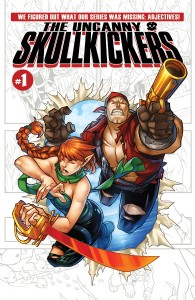 Image’s other #1 this week is really a new beginning in name only. It’s Uncanny Skullkickers #1, and it not only borrows an adjective from the annals of comics glory, but heavily draws on the storyline of previous Skullkickers books. In fact, the variant cover lists this book numbered as SkullKickers #19. It is a new story arc and entry point into the book, and there’s an unnamed Elf at the beginning who lays out the past events fairly succinctly. The SkullKickers are Rex and Kusia, man and elf respectively, who wander about a mystical world fighting monsters. Rex has a magical pistol that gets him into trouble, while Kusia is a masterful fighter with skills to spare who inexplicably talks to her sword. The sword talks back, but only in rhyme, only in the morning as if it’s her alarm clock, and only to her, just like the old WB singing frog. Also, in this issue there’s a running story about a Dwarven friend who drowned in a recent shipwreck that began the tale, floating face down dead in the briny ocean. The unnamed Dwarf appears at the bottom of each page, as various sea creatures poke around his lifeless corpse. Writer Jim Zub’s punchy dialogue is the key to the irreverent humor built into this fantasy action story. The style is light, with vibrant art by Edwin Huang, and if you’ve been looking for a way into this book, this is a good start. Kusia is well written as a capable fighter who never takes herself too seriously, and she’s got more skill and class than her counterpart Rex. She’d fail the Bechdel test, but only because she’s stranded on a desert island with only one other person. Indeed, she and Rex have no apparent romantic connection, thankfully, as the lighthearted humor wouldn’t mix well with romance.
Image’s other #1 this week is really a new beginning in name only. It’s Uncanny Skullkickers #1, and it not only borrows an adjective from the annals of comics glory, but heavily draws on the storyline of previous Skullkickers books. In fact, the variant cover lists this book numbered as SkullKickers #19. It is a new story arc and entry point into the book, and there’s an unnamed Elf at the beginning who lays out the past events fairly succinctly. The SkullKickers are Rex and Kusia, man and elf respectively, who wander about a mystical world fighting monsters. Rex has a magical pistol that gets him into trouble, while Kusia is a masterful fighter with skills to spare who inexplicably talks to her sword. The sword talks back, but only in rhyme, only in the morning as if it’s her alarm clock, and only to her, just like the old WB singing frog. Also, in this issue there’s a running story about a Dwarven friend who drowned in a recent shipwreck that began the tale, floating face down dead in the briny ocean. The unnamed Dwarf appears at the bottom of each page, as various sea creatures poke around his lifeless corpse. Writer Jim Zub’s punchy dialogue is the key to the irreverent humor built into this fantasy action story. The style is light, with vibrant art by Edwin Huang, and if you’ve been looking for a way into this book, this is a good start. Kusia is well written as a capable fighter who never takes herself too seriously, and she’s got more skill and class than her counterpart Rex. She’d fail the Bechdel test, but only because she’s stranded on a desert island with only one other person. Indeed, she and Rex have no apparent romantic connection, thankfully, as the lighthearted humor wouldn’t mix well with romance.
Romance 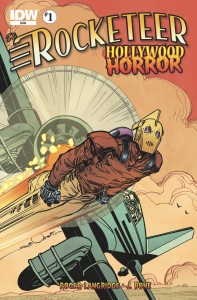 is deeply entrenched in IDW’s latest offering,however, Rocketeer: Hollywood Horror #1. Cliff Secord, the ‘30’s era pilot turned super hero who go the futuristic jetpack the rest of us were promised, is up to his old tricks, zooming around L.A. and trying to protect his girlfriend Betty from various dangers. Betty, to her credit, isn’t in the mood to be protected, but wants to help out her high-flying beau in his crime fighting. She’s determined to use her feminine wiles to “find things out so Cliff has to take fewer risks” (she uses those exact words twice no less) but Cliff is having none of it. While the art by J Bone is intentionally old fashioned befitting a 30’s serial, I wish Betty’s attitude and treatment were less so. Cliff is your typical 30’s era chauvinist, forbidding Betty to go anywhere near danger since girls can’t handle themselves, and Betty’s attitude towards empowering herself is very conflicted and doesn’t really help. In her first scene in the book, Betty has her only conversation with another woman and yup, you guessed it, it’s about Cliff, as she talks to her roommate while getting ready for her big date. It would also be nice if we could be introduced to Betty in something other than her underwear, which seemed gratuitous, even given the style of the pin-up era. Betty is a budding feminist, struggling to be free, but she doesn’t have a particularly good idea how to go about it. Her roommate, the intrepid reporter Dahlia, comes off as a much more fleshed out role model in the story, ready to risk anything to crack open the case of a missing scientist and a frightening monster. Hopefully she has more page time in the rest of this mini-series.
is deeply entrenched in IDW’s latest offering,however, Rocketeer: Hollywood Horror #1. Cliff Secord, the ‘30’s era pilot turned super hero who go the futuristic jetpack the rest of us were promised, is up to his old tricks, zooming around L.A. and trying to protect his girlfriend Betty from various dangers. Betty, to her credit, isn’t in the mood to be protected, but wants to help out her high-flying beau in his crime fighting. She’s determined to use her feminine wiles to “find things out so Cliff has to take fewer risks” (she uses those exact words twice no less) but Cliff is having none of it. While the art by J Bone is intentionally old fashioned befitting a 30’s serial, I wish Betty’s attitude and treatment were less so. Cliff is your typical 30’s era chauvinist, forbidding Betty to go anywhere near danger since girls can’t handle themselves, and Betty’s attitude towards empowering herself is very conflicted and doesn’t really help. In her first scene in the book, Betty has her only conversation with another woman and yup, you guessed it, it’s about Cliff, as she talks to her roommate while getting ready for her big date. It would also be nice if we could be introduced to Betty in something other than her underwear, which seemed gratuitous, even given the style of the pin-up era. Betty is a budding feminist, struggling to be free, but she doesn’t have a particularly good idea how to go about it. Her roommate, the intrepid reporter Dahlia, comes off as a much more fleshed out role model in the story, ready to risk anything to crack open the case of a missing scientist and a frightening monster. Hopefully she has more page time in the rest of this mini-series.
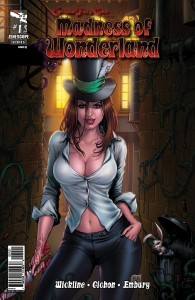
When it comes to gratuitously appalling representations of the female body, the boys (literally) at Zenescope Comics have it covered this week with two story arcs. The first of these is Madness of Wonderland #1, the first issue in the sequel to Zenescope’s previous Call of Wonderland. Part re-imagined fairy tale, part police procedural, this series is a classic example of what’s often wrong with depictions of female characters in comics, and certainly what’s wrong with Zenescope. MoW’s main character Det. Emma Legrasse has plenty of excellent qualities. She’s a driven career cop, and a strong woman with a solid sense of herself, despite a troubled past; she has her demons, as all good characters do, but she’s grounded and tough, willing to risk herself for others; she’s sharp, open minded, and sensitive when she needs to be. So why do we have to see her in the shower, with voice over narration happening while hot jets of steam engulf her heaving breasts? For me, the over-sexualized portrayal of the character ended up being distracting from the story, which isn’t saying much in the first place. This really is a sequel, and you’ll need to have read the first piece to make sense out of it. The Alice in Wonderland imagery is very loosely alluded to in the story, right up until the Mad Hatter shows up, depicted as a busty, loosely clad woman with a knife.
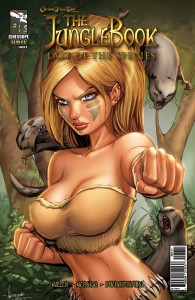 Much of the same could be said of Zenescope’s The Jungle Book: Last of the Species #1, also a sequel to a previous series re-imagining a classic tale. Kipling Island is home to several long warring animal tribes until the day a ship crash lands there, stranding not one but four human “cubs”. Taken as a sign of the end of the long war, the “cubs” are separated among the tribes, with our heroine, Mowgli, initially living with the wolves. Mowgli is now the orphan we know from the storybooks, living in the wild with the great Bear Baloo, last of his kind, and the panther Baghera. This Mowgli isn’t alone, however, and has a friend in the young woman Akili, who joined the Mearkat tribe. She also has a complicated relationship with a young man named Dewan, who was presumably given to the monkeys, and is incapable of coherent speech, even among animals. He also is the only person on the island who owns a real shirt. In this series, Mowgli has already defeated the Tiger tribe’s leader, the legendary Shere Kahn, whose human son Bomani now leads the Tigers. Bomani is ready to destroy the Elephant tribe, as his father decimated the Wolves, including Mowgli’s mother. Thus Mowgli and Akili romp about the jungle in there respective jungle style lingerie, and while they are ready to do good for others at their own risk, the gratuitous treatment of the characters gets in the way of appreciating it. Jungle Book does have an interesting short story at the end, a piece about the lost bear tribe without any humans in it at all, and it’s the best storytelling in the book. While it would obviously negate the whole point of the Jungle Book remix happening here, I couldn’t help but wish the entire comic was like the last few pages in this second story: free of humans altogether.
Much of the same could be said of Zenescope’s The Jungle Book: Last of the Species #1, also a sequel to a previous series re-imagining a classic tale. Kipling Island is home to several long warring animal tribes until the day a ship crash lands there, stranding not one but four human “cubs”. Taken as a sign of the end of the long war, the “cubs” are separated among the tribes, with our heroine, Mowgli, initially living with the wolves. Mowgli is now the orphan we know from the storybooks, living in the wild with the great Bear Baloo, last of his kind, and the panther Baghera. This Mowgli isn’t alone, however, and has a friend in the young woman Akili, who joined the Mearkat tribe. She also has a complicated relationship with a young man named Dewan, who was presumably given to the monkeys, and is incapable of coherent speech, even among animals. He also is the only person on the island who owns a real shirt. In this series, Mowgli has already defeated the Tiger tribe’s leader, the legendary Shere Kahn, whose human son Bomani now leads the Tigers. Bomani is ready to destroy the Elephant tribe, as his father decimated the Wolves, including Mowgli’s mother. Thus Mowgli and Akili romp about the jungle in there respective jungle style lingerie, and while they are ready to do good for others at their own risk, the gratuitous treatment of the characters gets in the way of appreciating it. Jungle Book does have an interesting short story at the end, a piece about the lost bear tribe without any humans in it at all, and it’s the best storytelling in the book. While it would obviously negate the whole point of the Jungle Book remix happening here, I couldn’t help but wish the entire comic was like the last few pages in this second story: free of humans altogether.
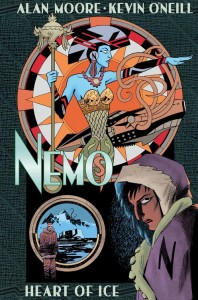 As honorable mentions, there are a couple of great women in one shots and the mysterious issue #0’s this week. The inimitable Alan Moore brings us the wonderful short graphic novel Nemo: Heart of Ice, a one shot from the world of his League of Extraordinary Gentleman. Captain Nemo is the daughter of the character from the original series, having taken command of her deceased father’s ship and crew, leading them on a dangerous expedition to the North Pole. Nemo is a woman exploring herself as much as the frozen world, and learning to find her own humanity amidst her father’s legend. This book comes in a wonderfully illustrated hardback edition, and is a stand-alone tale worth the cover price. Dark Horse brings Amala’s Blade #0, a prequel to the upcoming series taken from the pages of it’s Dark Horse Presents compendium title. Amala is a tough pirate warrior, with a bit of a steampunk style of her own, convinced she’s the best swordswoman in the realm, but only time will tell if she is. Lastly, Marvel gives us an issue #0.1, of all things, as a prequel to Guardians of the Galaxy. This is obviously an attempt to familiarize us with a little known band of heroes who will be the main characters in an upcoming big budget film. This one is the origin story of the main character, Star Lord, whose mother was a lady not to be trifled with. Check all three of these out if you get the chance, and we’ll review their #1’s issues when the hit store shelves in upcoming weeks. Until then, happy reading everyone!
As honorable mentions, there are a couple of great women in one shots and the mysterious issue #0’s this week. The inimitable Alan Moore brings us the wonderful short graphic novel Nemo: Heart of Ice, a one shot from the world of his League of Extraordinary Gentleman. Captain Nemo is the daughter of the character from the original series, having taken command of her deceased father’s ship and crew, leading them on a dangerous expedition to the North Pole. Nemo is a woman exploring herself as much as the frozen world, and learning to find her own humanity amidst her father’s legend. This book comes in a wonderfully illustrated hardback edition, and is a stand-alone tale worth the cover price. Dark Horse brings Amala’s Blade #0, a prequel to the upcoming series taken from the pages of it’s Dark Horse Presents compendium title. Amala is a tough pirate warrior, with a bit of a steampunk style of her own, convinced she’s the best swordswoman in the realm, but only time will tell if she is. Lastly, Marvel gives us an issue #0.1, of all things, as a prequel to Guardians of the Galaxy. This is obviously an attempt to familiarize us with a little known band of heroes who will be the main characters in an upcoming big budget film. This one is the origin story of the main character, Star Lord, whose mother was a lady not to be trifled with. Check all three of these out if you get the chance, and we’ll review their #1’s issues when the hit store shelves in upcoming weeks. Until then, happy reading everyone!

